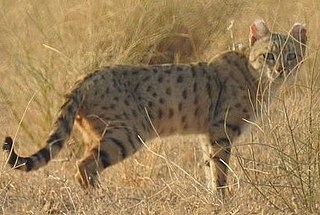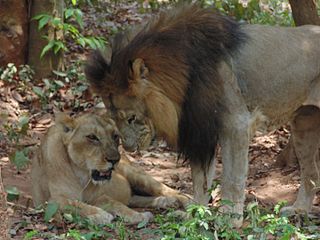 W
WThe Asiatic wildcat is an African wildcat subspecies that occurs from the eastern Caspian Sea north to Kazakhstan, into western India, western China and southern Mongolia. It is also known as the Asian steppe wildcat and Indian desert cat. The status Least Concern in the IUCN Red List is attributed to the wildcat species complex. There is no information on current status or population numbers for the Asiatic wildcat's entire range, but populations are thought to be declining.
 W
WThe fishing cat is a medium-sized wild cat of South and Southeast Asia. Since 2016, it is listed as Vulnerable on the IUCN Red List. Fishing cat populations are threatened by destruction of wetlands and have declined severely over the last decade. The fishing cat lives foremost in the vicinity of wetlands, along rivers, streams, oxbow lakes, in swamps, and mangroves.
 W
WThe Indian leopard is a leopard subspecies widely distributed on the Indian subcontinent. The species Panthera pardus is listed as Vulnerable on the IUCN Red List because populations have declined following habitat loss and fragmentation, poaching for the illegal trade of skins and body parts, and persecution due to conflict situations.
 W
WThe snow leopard, also known as the ounce, is a large cat native to the mountain ranges of Central and South Asia. It is listed as Vulnerable on the IUCN Red List because the global population is estimated to number less than 10,000 mature individuals and is expected to decline about 10% by 2040. It is threatened by poaching and habitat destruction following infrastructural developments. It inhabits alpine and subalpine zones at elevations from 3,000 to 4,500 m, ranging from eastern Afghanistan, the Himalayas and the Tibetan Plateau, to southern Siberia, Mongolia, and western China. In the countries in the northern part of its range, it also lives at lower elevations.
 W
WThe Asiatic lion is a Panthera leo leo population in India. Its current range is restricted to the Gir National Park and environs in the Indian state of Gujarat. Historically, it inhabited much of Western Asia and the Middle East up to northern India. On the IUCN Red List, it is listed under its former scientific name Panthera leo persica as Endangered because of its small population size and area of occupancy.
 W
WThe Turkestan lynx is a subspecies of Eurasian lynx native to Central Asia. It is also known as Central Asian lynx, Tibetan lynx or Himalayan lynx. It is widespread from west in Central Asia, from South Asia to China and Mongolia. There are 27,000 mature individuals in China as of 2013. It is proposed for the Turkestan lynx to be listed as Vulnerable in Uzbekistan.
 W
WPanthera leo leo is a lion subspecies, which is present in West Africa, northern Central Africa and India. In West and Central Africa it is restricted to fragmented and isolated populations with a declining trajectory. It has been referred to as the 'Northern lion'.
 W
WThe rusty-spotted cat is one of the cat family's smallest members, of which historical records are known only from India and Sri Lanka. In 2012, it was also recorded in the western Terai of Nepal. Since 2016, the global wild population is listed as Near Threatened on the IUCN Red List as it is fragmented and affected by loss and destruction of prime habitat, deciduous forests.
 W
WThe Bengal tiger is a tiger from a specific population of the Panthera tigris tigris subspecies that is native to the Indian subcontinent. It is threatened by poaching, loss, and fragmentation of habitat, and was estimated at comprising fewer than 2,500 wild individuals by 2011. None of the Tiger Conservation Landscapes within its range is considered large enough to support an effective population of more than 250 adult individuals. India's tiger population was estimated at 1,706–1,909 individuals in 2010. By 2018, the population had increased to an estimated 2,603–3,346 individuals. Around 300–500 tigers are estimated in Bangladesh, 220–274 tigers in Nepal and 103 tigers in Bhutan.